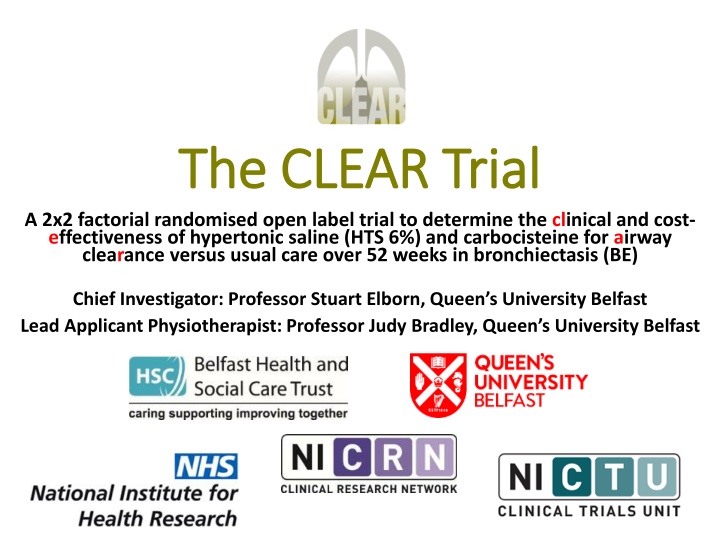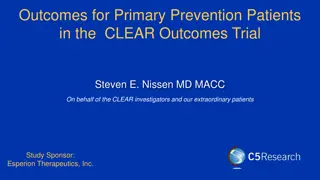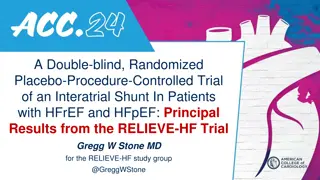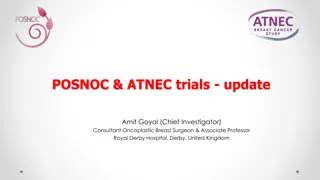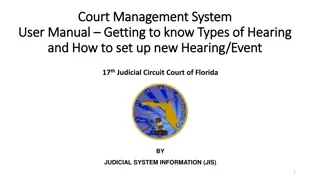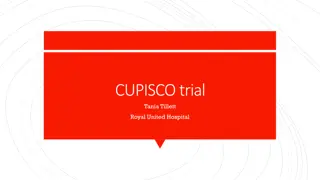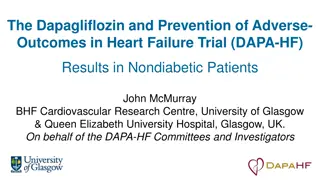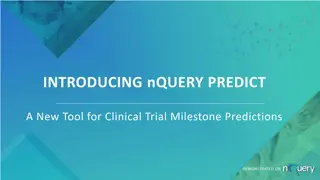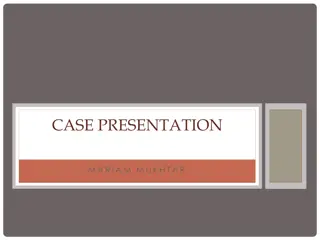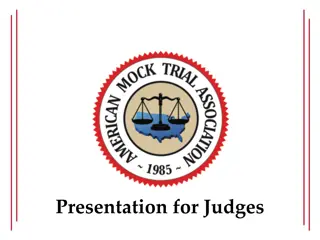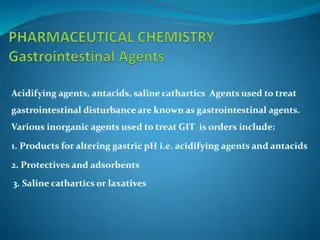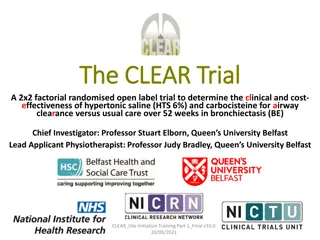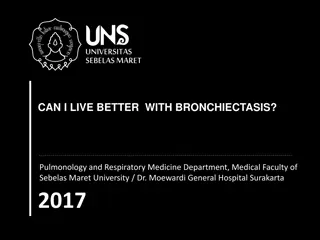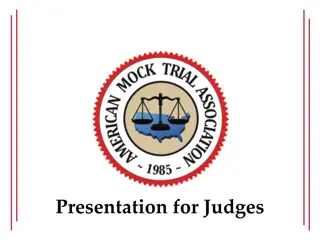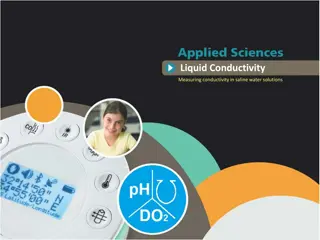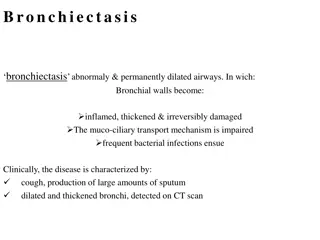The CLEAR Trial: Investigating Hypertonic Saline and Carbocisteine for Bronchiectasis Patients
The CLEAR Trial, led by Professor Stuart Elborn and Professor Judy Bradley, aims to assess the clinical and cost-effectiveness of hypertonic saline and carbocisteine for airway clearance in bronchiectasis patients over 52 weeks. The trial involves a 2x2 factorial design and various study sites across different NHS Trusts, focusing on important aspects like site initiation training and trial personnel requirements. Key components include background information, study objectives, participant criteria, and collaborating with multiple healthcare professionals.
Download Presentation

Please find below an Image/Link to download the presentation.
The content on the website is provided AS IS for your information and personal use only. It may not be sold, licensed, or shared on other websites without obtaining consent from the author.If you encounter any issues during the download, it is possible that the publisher has removed the file from their server.
You are allowed to download the files provided on this website for personal or commercial use, subject to the condition that they are used lawfully. All files are the property of their respective owners.
The content on the website is provided AS IS for your information and personal use only. It may not be sold, licensed, or shared on other websites without obtaining consent from the author.
E N D
Presentation Transcript
The CLEAR The CLEAR Trial A 2x2 factorial randomised open label trial to determine the clinical and cost- effectiveness of hypertonic saline (HTS 6%) and carbocisteine for airway clearance versus usual care over 52 weeks in bronchiectasis (BE) Trial Chief Investigator: Professor Stuart Elborn, Queen s University Belfast Lead Applicant Physiotherapist: Professor Judy Bradley, Queen s University Belfast
Site Initiation Training Breakdown Site Initiation Training Breakdown The SIV training is divided into 7 parts. Please see below the 6 parts in order and the trial personnel that need to be present for each. 1. 2. 3. 4. 5. 6. Introduction & Study Background - All (including Doctors) Pharmacovigilance - All (including Doctors) Visits & Assessments - All (including Doctors) Exacerbation Management - All (including Doctors) DRA - Anyone who will complete DRA Systems - Randomisation system (anyone involved in randomisation) & Study database (anyone involved in data entry & PI) PARI device, equipment & software (anyone involved with trial equipment) 7.
Site Initiation Training Part 1: Background Site Initiation Training Part 1: Background Clinical/CTU Clinical/CTU Study Sites, Timelines & Contacts Study Background, Objectives & Outcomes Inclusion & Exclusion Criteria Sub studies and SWAT Trial Awareness for Patients
Study Sites Study Sites PI Trust 1 Dr Martin Kelly Western Health and Social Care Trust 2 Dr John Hurst Royal Free London NHS Foundation Trust 3 Prof Adam Hill NHS Lothian 4 Dr Anthony de-Soyza The Newcastle Upon Tyne Hospitals NHS Foundation Trust 5 Prof Michael Loebinger Royal Brompton and Harefield NHS Foundation Trust 6 Dr Damien Downey Belfast Health and Social Care Trust 7 Prof James Chalmers NHS Tayside 8 Dr Muhammed Anwar The Princess Alexandra Hospital NHS Trust 9 Dr Mary Carroll University Hospital Southampton NHS Foundation Trust 10 Dr Rory Convery Southern Health and Social Care Trust 11 Dr Timothy Gatheral University Hospitals of Morecambe Bay NHS Foundation Trust 12 Dr Anita Sullivan University Hospital Birmingham NHS Foundation Trust 13 Dr William Flight Oxford University Hospitals NHS Foundation Trust 14 Dr Alina Ionescu Aneurin Bevan University Health Board 15 Dr M Etumi Blackpool Teaching Hospital NHS Foundation Trust 16 Dr Jamie Duckers Cardiff & Vale University Hospital 17 Dr Mitra Shahidi Stoke Mandeville Hospital 18 Dr John Steer Northumbria Healthcare NHS Foundation Trust 19 Dr Terence McManus Omagh & SWAH Hospital
New Study Sites New Study Sites* * Potential New Sites PI Trust Paul Whitaker Bradford Teaching Hospitals NHS Foundation Trust Liz Fuller South Tyneside NHS Foundation Trust Veeresh Patil Milton Keynes University Hospital MHS Foundation Trust Guy Hagan Sandwell and West Birmingham NHS Foundation Trust *Updated as of 03/08/2022
Study Study Timelines Timelines Study Milestones To date, 218 patients have been randomised across the 19 active study sites. Site Research Management Permissions Feb 2019 Pilot Study Recruitment Jun 2018 to Feb 2019 Main Study Recruitment Start Feb 2019 The overall recruitment target for the study is patients 288 March 2020 to September 2021 Recruitment Paused Recruitment restart following hibernation October 2021 Recruitment End*** September 2023 Analysis & Reporting Complete March 2025
Study Contacts Study Contacts Main Contact: CLEAR Trial Team Northern Ireland Clinical Trials Unit (NICTU) 7 Lennoxvale Malone Road Belfast BT9 5BY Tel: +4428 9615 1447 Email: CLEAR@nictu.hscni.net Clinical Trial Manager: Andrew Jackson Clinical Trial Coordinator: Rachael McQuillan Chief Investigator: Professor Stuart Elborn - s.elborn@qub.ac.uk Lead Applicant Physiotherapist: Professor Judy Bradley - judy.bradley@qub.ac.uk Sponsor: Belfast Health and Social Care Trust (BHSCT) Funder: National Institute for Health Research (NIHR)
CLEAR Study Background CLEAR Study Background Greater numbers of patients now being diagnosed with BE, with patients usually suffering from a persistent cough, chronic daily sputum expectoration, recurrent chest infections and a poor HRQoL. CLEAR is particularly concerned with exploring if HTS and carbocisteine, or a combination of these medicines, help patients bring up their sputum more easily. We want to find out if patients with bronchiectasis have fewer exacerbations if they use hypertonic saline, carbocisteine, or both of these medicines together for 52 weeks.
CLEAR Study Aim CLEAR Study Aim To deliver a UK multicentre study that will determine the clinical and cost-effectiveness of hypertonic saline HTS (6%) and carbocisteine for airway clearance versus usual care over 52 weeks in BE using a 2x2 factorial randomised open label trial
Primary Objective Primary Objective Primary Objective: To determine whether HTS (6%) and/or carbocisteine reduce the mean number of exacerbations over 52 weeks post-randomisation Primary Outcome Measure: Mean number of exacerbations over 52 weeks
Secondary Objectives Secondary Objectives To determine if HTS/carbocisteine: Improve disease specific health related quality of life (HRQoL) at 52 weeks Reduce time to next exacerbation Reduce number of days of antibiotics related to exacerbations over 52 weeks Improve generic HRQoL Are acceptable from a patient satisfaction perspective at 52 weeks Are associated with Adverse Events (AEs) Improve lung function over 52 weeks To assess: The cost-effectiveness of the four treatment options Patient adherence to HTS and carbocisteine over 52 weeks and how this impacts the overall results
Secondary Outcome Measures Secondary Outcome Measures Disease-specific HRQoL (respiratory symptoms of domain of QoL-B) at 52 weeks Time to next exacerbation post-randomisation Number of days of antibiotics related to exacerbations over 52 weeks Generic HRQoL Health Service use over 52 weeks QALY over 52 weeks Measurement of health impairment using the SGRQ Patient preferences for treatment Adverse Events over 52 weeks Lung function over 52 weeks Adherence to HTS and carbocisteine over 52 weeks
Patients with BE will be recruited from a maximum of 24 sites (including representation from the BRONCH-UK, EMBARC, NIHR or NICRN portfolio) Patient eligibility assessed Randomised to study using an automated concealed randomisation (n=288) Patient excluded: Failure to meet inclusion criteria Consent declined Other reasons Intervention 2: Standard care and carbocisteine 750 mg administered 3x daily until visit 3 then 750 mg administered twice daily n=72 Intervention 3: Standard care and nebulised HTS (6%) twice daily and carbocisteine 750 mg administered 3x daily until visit 3 then 750 mg administered twice daily n=72 Intervention 4: Standard care n=72 Intervention 1: Standard care and nebulised HTS (6%) twice daily n=72 Analysis at year 1: n= expected greater than 243 Patients lost to follow-up in primary outcome (15%) Primary outcome: Mean number of exacerbations in 52 weeks Secondary outcomes: QoL-B, Time to next exacerbation, HRQoL, Healthcare Service Use, QALY, SGRQ, Patient Preferences, Adverse Events, Lung Function, Adherence to HTS and carbocisteine.
Inclusion Criteria Inclusion Criteria Diagnosis of BE on high resolution computed tomography (HRCT)/computed tomography (CT) scans BE must be the primary respiratory diagnosis One or more pulmonary exacerbations in the last year requiring antibiotics * Production of daily sputum** Stable from a respiratory point of view for 14 or more days before the first study visit with no changes to treatment*** Willing to continue any other existing chronic medication throughout the study Female subjects must be either surgically sterile, postmenopausal, or agree to use effective contraception during the treatment period of the trial * This can include patient-reported exacerbations ** This includes patients who expectorate sputum on a daily basis and/or patients that expectorate sputum on most days but experience difficulty in expectoration on other days. (4-5 days per week as a guide) *** This inclusion refers to chest treatment however some antibiotics (e.g. for a urinary tract infection (UTI) may have chest coverage and need to be considered.
Exclusion Criteria Exclusion Criteria Age <18 years old Patients with cystic fibrosis Patients with COPD as a primary respiratory diagnosis Current smokers, female ex-smokers with greater than 20 pack years and male ex- smokers with greater than 25 pack years FEV1 <30% If being treated with long term macrolides or other long term antibiotic, on treatment for less than one month before joining the study# Patients on regular isotonic saline## Treatment with HTS, carbocisteine or any mucoactives within the past 30 days### #If a patient is currently prescribed long term macrolides or other long term antibiotic they must have had no change to their treatment within the 30 days prior to randomisation i.e. if they are prescribed macrolides on a seasonal basis they must not have stopped or started treatment within the 30 days prior to being randomised. ##Short term use of isotonic saline for exacerbation management is not an exclusion criteria. In addition patients using isotonic saline as a mixer for colomycin or using saline nasal sprays are not excluded ### Patients who use HTS and/or carbocisteine very occasionally or PRN i.e. during an exacerbation and have not used within 30 days prior to randomisation are not excluded.
Exclusion Criteria Exclusion Criteria Known contraindication or intolerance to HTS or carbocisteine Hypersensitivity to any of the active ingredients or the excipients of carbocisteine Active peptic ulceration Any hereditary galactose intolerance, Lapp lactase deficiency, or glucose-galactose malabsorption Patients unable to swallow oral capsules Women who are pregnant or lactating Participation in other trials of investigational medicinal products within 30 days Please Note: Please ensure local COVID guidance is followed with regards to the conduct of clinical trial activities. Patients should not be recruited until 1 month post recovery from COVID (discussed on a case by case basis).
HTS/ HTS/Carbocisteine Carbocisteine Washout Washout If the patient is currently prescribed HTS, carbocisteine or other mucoactives for the treatment of their BE and the patient wants to be part of the trial, the patient and physician can decide to do a washout Informed consent should be taken prior to washout Patients should stop regular mucoactive treatment for at least 30 days Confirmation of eligibility and baseline assessments completed following the washout The patient cannot be randomised until after the washout and eligibility is confirmed
Smoking Pack Smoking Pack Years Years Calculation Calculation For ex-smokers the number of pack years must be calculated to confirm eligibility: Number of pack years If a patient has smoked a different number of cigarettes per day a manual calculation must be completed e.g. = No. of cigarettes smoked per day 20 X No. of years smoked 20 per day X 20 years = 20 pack years PLUS 10 per day X 10 years = 5 pack years TOTAL: 25 PACK 20 20 YEARS Pipe Smokers: 1 pipe = 2.5 cigarettes Pack Years Calculator URL: https://www.smokingpackyears.com/
Sub Sub- -Studies Studies Sub-Study 1 Title: Validity and sensitivity of the EMBARC definition for exacerbations in bronchiectasis Aim: To compare the criteria in the EMBARC definition to the criteria of a modified Fuch s definition for diagnosing pulmonary exacerbations in BE patients your site?: What additional does this mean for Nothing Sub-Study 2 Title: Spirometry Sub-Study Aim: To explore the use of mySpiroSense for remote spirometry during periods of stability and at the start and end of exacerbations in BE patients
SWAT C SWAT C SWAT C- Investigate response to giving trial patients a thank you note 1. Giving the participants a thank you card with their name on it and signed in wet ink by the study staff 2. Generic thank you card not including the patients name is generically signed and printed electronically as The Clear Team 3. No card is given
EME Sputum Sub EME Sputum Sub- -study* (*only in participating sites) (*only in participating sites) study* Aim: Is the mechanism of action of hypertonic saline and/or carbocisteine in the treatment of patients with bronchiectasis due to a decrease in sputum viscoelasticity, inflammation and bacterial load?
EME Sputum Sub EME Sputum Sub- -study* (*only in participating sites) (*only in participating sites) study* Primary Objective: to measure sputum viscosity (G ) and elasticity (G ) (which combined give a single summary measure of sputum viscoelasticity called the yield stress, Tc) at the initial visit and 2 weeks following commencement of treatment with HS and/or CS. Secondary Objectives: 1). Measure sputum viscoelasticity (yield stress, Tc), at 8 weeks following commencement of treatment with HS and/or CS. 2). Evaluate sputum inflammation as measured by IL-6, IL-8 and 8-isoprostane levels at the initial visit, 2 and 8 weeks following commencement of treatment with HS and/or CS. 3). Evaluate sputum bacterial load/composition at the initial visit, 2 and 8 weeks following commencement of treatment with HS and/or CS. The overall aim of this study is to provide mechanistic insight into the action of HS and/or CS in bronchiectasis
Trial Awareness for Patients Trial Awareness for Patients Patient information posters to be displayed in your clinics Patient newsletters to be displayed in your clinics or provided to currently enrolled and potential participants
